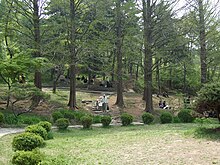Moranbong
| Moran Hill | |
 | |
| Korean name | |
|---|---|
| Chosŏn'gŭl | 모란봉 |
| Hancha | |
| Revised Romanization | Moranbong |
| McCune–Reischauer | Moranbong |
Moran Hill is located in the central part of Pyongyang, the capital of the North Korea. The hill is noted for its curious features and scenery, as well as its political significance.
The hill is associated with the revolutionary history of President Kim Il-sung, leader Kim Jong Il and anti-Japanese heroine Kim Jong Suk. At the foot of the hill Kim Il-sung in the 1940s allegedly gave a public speech after returning from exile. There are multiple monumental structures located on Moran Hill. They include the Arch of Triumph, Kim Il-sung Stadium, the monument to President Kim Il-sung's handwritings from his address at a rally to welcome him when he returned to Pyongyang and the mural painting in commemoration of President Kim Il-sung's speech on his return. At the foot of the hill is the Jonsung revolutionary site, which conveys the "revolutionary achievements" of President Kim Il-sung and the Hungbu revolutionary site which is associated with the history of leader Kim Jong Il and includes trees bearing slogans written during the anti-Japanese revolutionary struggle.
The area surrounding the hill is now a recreation area, including the Moranbong Theatre, the Kaeson Youth Park, an open-air theatre in the Youth Park, the Moran Restaurant, an afforestation exhibition and a small zoo. The Okryu Restaurant is also located nearby.[1]
The Youth Park at the foot of the Moran Hill near the Tong Il underground station featured the United Buddy Bears exhibition in October 2008 - an array of 18 two metre-high sculptures, each designed by a different artist, touring the world as a symbol of cultural understanding, tolerance and mutual trust. It was the first exhibition in North Korea that was accessible for everyone and open to everybody. According to official information, around 100,000 visitors were counted every week in Pyongyang.[2]
See also
References
- ^ "Okryu restaurant", Korean Central News Agency, 1998-08-31, retrieved 2010-06-25
- ^ Pyongyang 2008 - Exhibition of the United Buddy Bears
External links
Naenara: Democratic People's Republic of Korea. "Tourism in Korea". link. Last accessed on Mar. 6, 2006.
